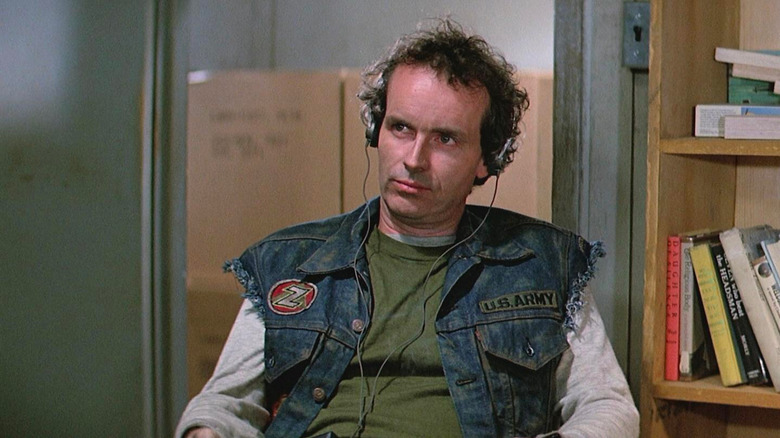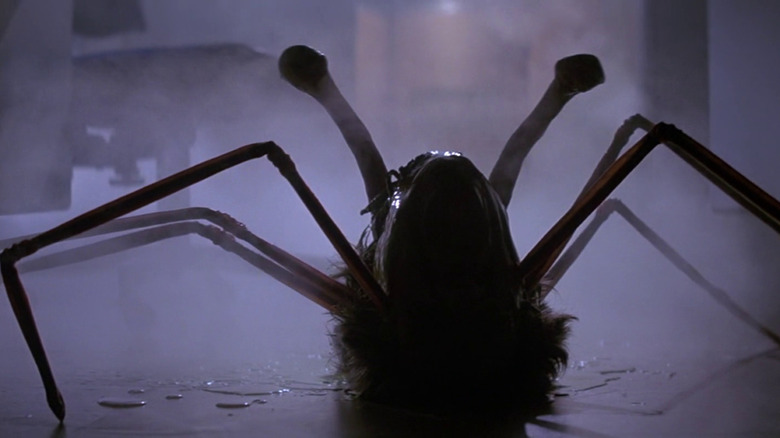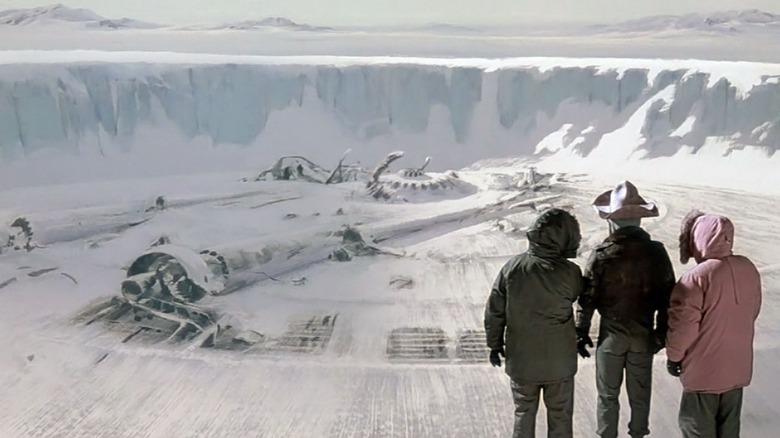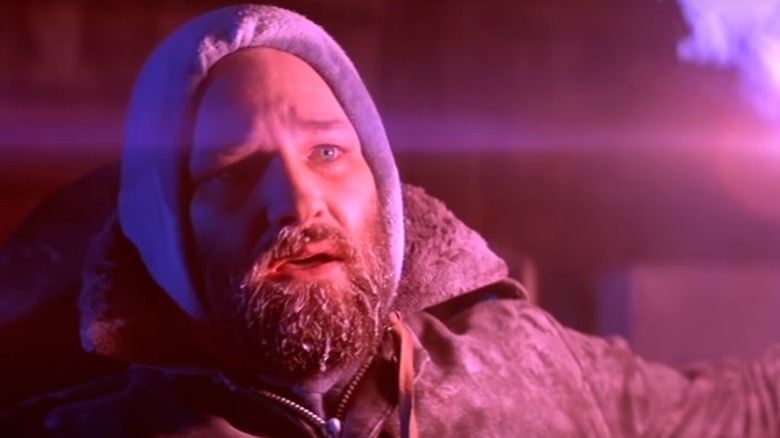David Clennon Thinks He Knows Why The Thing Struggled At Release (And It Wasn't E.T.)
John Carpenter's "The Thing" may be widely regarded as a sci-fi horror masterpiece nowadays, but it suffered a gruesome reception when it was first released in the summer of 1982. Critics savaged it, citing everything from lack of characterization to excessive gore; Vincent Canby of the New York Times dismissed it as "instant junk" while Roger Ebert called it a "great barf-bag movie." Opinions of film critics don't always correlate with the tastes of the film-going public, of course, but audiences also stayed away in droves. While "The Thing" made a small profit, it was far from the box office hit that executives at Universal expected.
The frosty reception also brought Carpenter's excellent early run to an end, after "Assault on Precinct 13," "Halloween," "The Fog," and "Escape From New York" established him as a major genre filmmaker whose movies also made decent bank. Thankfully, "The Thing" didn't disappear without a trace after its inglorious debut; like its grotesque shapeshifting creature, it slunk off into the shadows and found a new form to lie in wait for impressionable horror fans: Home video.
Common wisdom suggests that Universal executives made a bad decision releasing it just a few weeks after an altogether friendlier visitor from outer space started cleaning up at the box office. In its opening two weeks, "E.T. the Extra-Terrestrial" took more money than "The Thing" would during its entire run, on its way to almost $800 million worldwide (via Box Office Mojo). But was its proximity to Spielberg's heartwarming classic that caused "The Thing" to flop? David Clennon, who played stoner helicopter pilot Palmer in the film, has his own theory.
So what happens in The Thing again?
As the Antarctic winter sets in, 12 men at an American research station while away the time playing cards, verbally abusing the chess computer, and re-watching old game shows on video. Their tedium is interrupted when a helicopter from the nearby Norwegian base approaches with its crew hellbent on killing a sled dog. The pilot dies when the passenger accidentally blows the helicopter up with a grenade before rampaging into the American base with a rifle. He is shot dead in self-defense by Garry (Donald Moffat), the station commander.
Helicopter pilot R.J. MacMurphy (Kurt Russell) heads out with Dr. Copper (Richard Dysart) to see what's up at the Norwegian camp and finds a scene of devastation. Everyone is dead and a strangely deformed body is smoldering in a fire outside. They take the remains back to camp for an autopsy, and biologist Blair (Wilford Brimley) finds nothing wrong with the corpse internally. But, as MacMurphy notes, the Norwegians sure wanted to burn it up in a hurry.
Things kick off when the dog, now kept in the kennels with the American sled team, turns into a horrible creature and tries to absorb the other dogs. The men are alerted but part of the creature escapes. Blair performs another autopsy on the mutated dog and surmises that it is an organism that can perfectly replicate other life forms. Evidence recovered from the Norwegian camp suggests the ill-fated team found a spacecraft buried for thousands of years under the ice.
This doesn't bode well for the Americans as heavy weather sets in and the Thing targets the crew one by one, leading to accusations, paranoia, and power struggles. If the creature can replicate a living being perfectly then any one of them could be the Thing...
Was the large ensemble the reason for The Thing's failure?
David Clennon, who delivered arguably the film's most famous swear line as Palmer, thinks the size of the ensemble cast may have left audiences cold on "The Thing." He remembered (via LA Weekly):
"I think I saw the film at a cast-and-crew screening. Alien was still fresh in my mind. That film was very effective because you had a clear fix on who each of the characters were. So when the alien was stalking a particular crew member, you had an emotional investment in that character."
Clennon also revealed screenwriter Bill Lancaster provided some character-building scenes for each of the men, which were shot but left out of the final cut by John Carpenter:
"It was a little fuzzy at first: 'Who's that guy? Is he the biologist? The geologist? The company doctor? Should I care?' I think that made it harder for a general audience to get involved in The Thing."
Did the lack of audience identification with the characters contribute to the film's failure? It's possible, although I never had a problem with the characters. Kurt Russell is a strong lead and the other major players are all clearly identifiable; we don't get any back story on these guys, but the casting and screenwriting are a masterclass in economical characterization. Each of the men is played by a great character actor who also looks distinctive physically from the next; they are so well cast that it is still easy to tell who is who even when they're bundled up in parkas. Each person's reactions feel completely believable under the circumstances; part of the joy of the profane dialogue is that their responses to the monster mayhem unfolding around them feel exactly how real people would react.
What else could have been the problem?
Looking back, it is perhaps easier to figure out why "The Thing" didn't strike a chord with summer audiences. "Jaws" proved seven years earlier that there was a huge appetite for scares in the hot months, but then Steven Spielberg's blockbuster was set on a bright and sunny 4th of July weekend. John Carpenter's splattery film, on the other hand, is set in just about the least summery place you can imagine and its tone is bleak and paranoid. Then there is the nature of the horror; Rob Bottin's landmark special effects were extreme for the time, violently corrupting the bodies of dogs and men in a variety of perverse mutations. It's not exactly popcorn material, which Carpenter later acknowledged in an interview with Starlog (via Den of Geek):
"I was called 'a pornographer of violence.' I had no idea it would be received that way... 'The Thing' was just too strong for that time. I knew it was going to be strong, but I didn't think it would be too strong... I didn't take the public's taste into consideration."
Then comes the downbeat conclusion as two survivors, each suspicious of the other, wait to freeze to death as they share a bottle of whiskey. It's a brilliantly bleak and ambiguous ending, but one that people may not have been looking for when they were just looking for a good time at the movies on a summer's evening.
"The Thing" went on to build a strong cult following on home video and TV, which has led to it becoming the established masterpiece it is today. In many ways, watching at home was the perfect way to discover the film; I remember peering fearfully into the grainy image of a rental copy on my 13-inch TV, wondering where the creature would pop out next...



